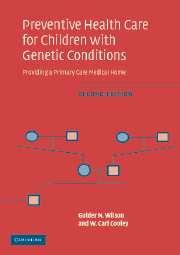Book contents
- Frontmatter
- Contents
- Preface
- Glossary of genetic and molecular terms
- Part I Approach to the child with special needs
- 1 Approach to the child with genetic disease
- 2 Providing a primary care medical home for the child with a developmental disability
- 3 Approach to preventive management
- Part II The management of selected single congenital anomalies and associations
- Part III Chromosomal syndromes
- Part IV Syndromes remarkable for altered growth
- Part V Management of craniofacial syndromes
- Part VI Management of connective tissue and integumentary syndromes
- Part VII The management of neurologic and neurodegenerative syndromes
- Part VIII Management of neurodegenerative metabolic disorders
- References
- Index
1 - Approach to the child with genetic disease
Published online by Cambridge University Press: 29 January 2010
- Frontmatter
- Contents
- Preface
- Glossary of genetic and molecular terms
- Part I Approach to the child with special needs
- 1 Approach to the child with genetic disease
- 2 Providing a primary care medical home for the child with a developmental disability
- 3 Approach to preventive management
- Part II The management of selected single congenital anomalies and associations
- Part III Chromosomal syndromes
- Part IV Syndromes remarkable for altered growth
- Part V Management of craniofacial syndromes
- Part VI Management of connective tissue and integumentary syndromes
- Part VII The management of neurologic and neurodegenerative syndromes
- Part VIII Management of neurodegenerative metabolic disorders
- References
- Index
Summary
Medical genetics is a harlequin specialty. One side is bright with the power of DNA diagnosis and genotyping; the other is darkened by ignorance of complex phenotypes. Fortunately, the molecular revolution is proceeding so rapidly that even complex syndromes are being drawn into the light of genetic analysis. For a growing number of developmental and/or metabolic disorders, proper recognition and referral can lead to definitive diagnostic testing. It is thus extremely important for practitioners to be familiar with common presentations of genetic and developmental diseases, allowing affected children and their families to receive the benefits of informed management and genetic counseling.
A correct diagnosis is the gateway to anticipatory guidance and case management. Although the primary care physician may not be the first practitioner to establish the correct diagnosis, it is essential that he or she be able to incorporate specialty opinions and laboratory data into a comprehensive care plan. It is not necessary for practitioners to know long lists of eponymic disorders, but it is necessary that they recognize the possibility of genetic or congenital disease so that appropriate referrals and information can be obtained.Computerized databases such as Online Mendelian Inheritance in Man (OMIM – www.ncbi.nlm.nih.gov/entrez) with links to genome and literature databases of the National Institutes of Health, Recognizable Patterns of Human Malformation (Jones, 1997), Syndromes of the Head and Neck (Gorlin et al., 2001), and The Metabolic and Molecular Bases of Inherited Disease (Scriver et al., 2001) are available to provide details on particular diseases.
- Type
- Chapter
- Information
- Preventive Health Care for Children with Genetic ConditionsProviding a Primary Care Medical Home, pp. 3 - 20Publisher: Cambridge University PressPrint publication year: 2006



